Review of the T-Force Cardea A440 PCIe Gen 4 NVMe SSD
Of all the SSD brands that I have been reviewing in the last 12 months or so, very few have had the meteoric impact of TeamGroup (and their T-Force series of SSDs). That isn’t to say that the brand has not been around for a long time (originally established in the late 90s in fact) but they have been incredibly prolific in the PCIe Gen 4 generation of M.2 NVMe SSDs and their gamer-focused Cardea series has been especially popular in the PC gaming world. However, the Teamgroup T-Force Cardea A440 series being compatible with the PS5 SSD expansion has introduced this largely PC-known brand into the field of knowledge of many, many console gamers. The T-Force A440 brand splinters off into several different sub-series (Pro Special, etc) and today I want to review the T-Force Cardea A440 from TeamGroup, their 7000MB/s+ performing NVMe SSD that includes multiple heat dissipation options, Phison E18 architecture and has confirmed PS5 compatibility. In today’s review, I will be looking at the design of this SSD, the components, the effectiveness of the heatsink and benchmarks of PC and PS5 use. So, let’s not waste any more time, let’s find out if the T-Force Cardea A440 deserves your data?
T-Force Cardea A440 SSD Review – Quick Conclusion
The TeamGroup T-Force Cardea A440 started off in my eyes as ‘another Phison E18 SSD’, but very quickly became a genuinely stand out purchase indeed! Whatever way you look at it, the T-Force Cardea A440 drive is delivering exactly what it intends. In terms of performance, the 1TB SSD benchmarked 7000MB/s Seq Read and 6000MB/s sequential write straight out the gate and 860K IOPS without breaking a sweat. In terms of hardware, it arrives with exactly the top tier Controller+NAND+Mmeory combo that I would want to see in the PCIe4 storage tier. And in terms of Value, the SSD arrives at a competitive price point over many of its peers, whilst still proving two very useful heat dissipated options at no additional cost. Add PS5 dependant factors, such as the 6,500MB/s repeated console benchmark and a heatsink that happens to align very well with the PS5 designs cooling system and you can see how TeamGroup have gone from relative obscurity with console gamers to suddenly being a commonly mentioned name! PC users might be able to find a few better choices out there than the T-Force Cardea A440 in 2022 (with a T-Force Cardea PCIe 5 SSD reportedly making its way in H2 of the year and PCs having the better capability to harness 1 Million 4K IOPS SSDs above this one), but for the middle of the road PC gamers and PS5 gamers, the T-Force Cardea A440, there are very few better SSDs in the market right now you can choose over this one.
T-Force Cardea A440 SSD Review – Packaging
The retail box of the T-Force Cardea A440 is pretty much what you might expect. Arriving in a petite package that still shouts quite loudly from all angles that THIS is a very high-performance SSD! The retail package itself does not include any paperwork relating to the setup, warranty or troubleshooting, instead providing that kind of information on the rear of the box.
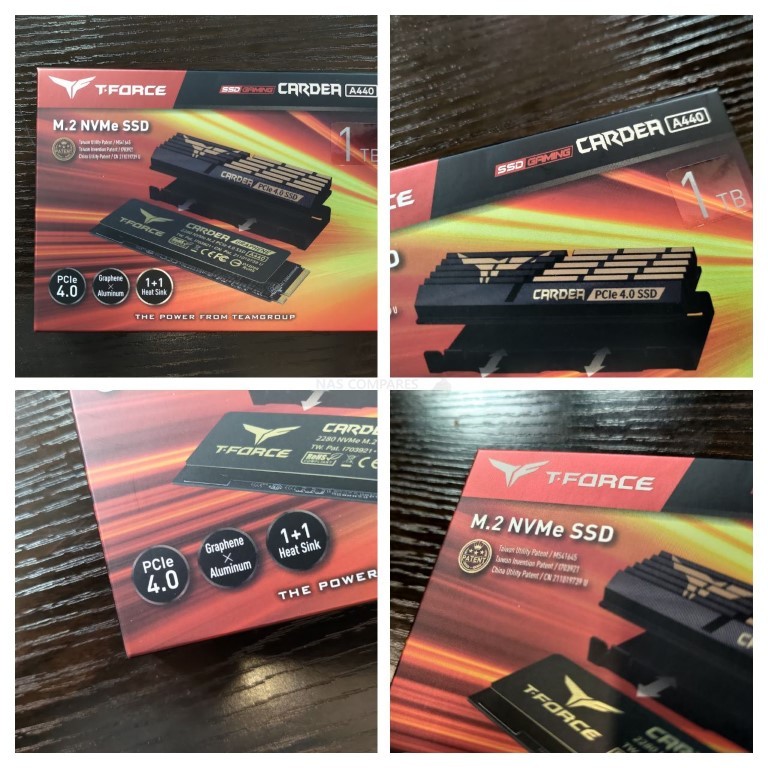
Opening the retail box, we find the T-Force Cardea A440 SSD and both heat dissipation options held in a plastic moulded shell. It is a bit flimsy, but I’ll be damned if I could get the SSD out easily – it was held in there INCREDIBLY well! SSDs, unlike their more mechanical alternatives in HDDs, are far less susceptible to shock damage in transit, however, it is still quite a light amount of protection. Though, to be fair, 80-80% of all SSDs arrive in this fashion, so the T-Force Cardea A440 is hardly a stand up villain on this one!

The larger heatsink additional extra stands out particularly tall against the SSD itself and gives you some idea how coversome this panel is going to be when deployed. The flexible heatshield is packaged underneath the T-Force Cardea A440 SSD.

The 1TB model of the T-Force Cardea A440 is a single-sided (SR or Single Rank) SSD, so the rear of the SSD simply has the manufacturers label that denotes the model number, serial number, firmware revision, etc.

Laying the entire contents out, it is actually quite a good-sized bundle and the inclusive option of two different heat dissipation solutions with the T-Force Cardea A440 (whilst the drive still arrives at a very competitive price vs similar performing drives in the market) has to be respected and applauded. Though some less experienced or tentative buyers might have preferred one of the heatsinks to be applied at the factory level instead (personally, I would prefer the option to choose and do it myself – so I approve!).

The two heat dissipation options that the T-Force Cardea A440 arrive with are quite distinct and are suited to very different deployments. PC users will welcome the larger and angular designed heatsink, whereas PS5 users might want to consider the thinner/shorter stacked heat shield, as the larger heatsink will not fit inside the PS5 expansion bay with the aluminium plate cover in place.

A closer look at the heat shield dissipation panel shows that it is a thin, metallic strip that is designed to adhesively stick to the SSD top (where the controller is located, important) and draw heat away from the components as much as possible. However, this panel is single-use and aside from the adhesive being considerably less efficient if re-use is attempted, the shape and smoothness of the heatshield will be impaired and contact with the SSD components will be lessened with repeated use.

The traditionally larger and angular slit designed heatsink on the other hand will be much more familiar to PC users and is arguably more effective than the heatshield in sustained use. Branded with the T-Force logo and branding, this is definitely the stronger heat management option that the T-Force Cardea A440 arrives with.

Additionally, the T-Force Cardea A440 larger heatsink option can be deployed and re-deployment over and over, with the thermal panels it arrives with being reusable and easily replaceable. Also, the heatsink is a surrounding design, so it sits under and on top of the T-Force Cardea A440, with a thermal pad on either side to help conductivity into the metal of the heatsink. Certainly the preferred choice.

When installed, the heatsink completely covers the T-Force Cardea A440 SSD and interestingly, although the heatsink is too tall to fit into the PS5 M.2 slot with the cover it, the slits and angle of the heatsink align with the PS5 vents. I am unsure if this was an intentional design choice (as this heatsink has been around for quite a while) but it’s an unexpected bonus indeed.
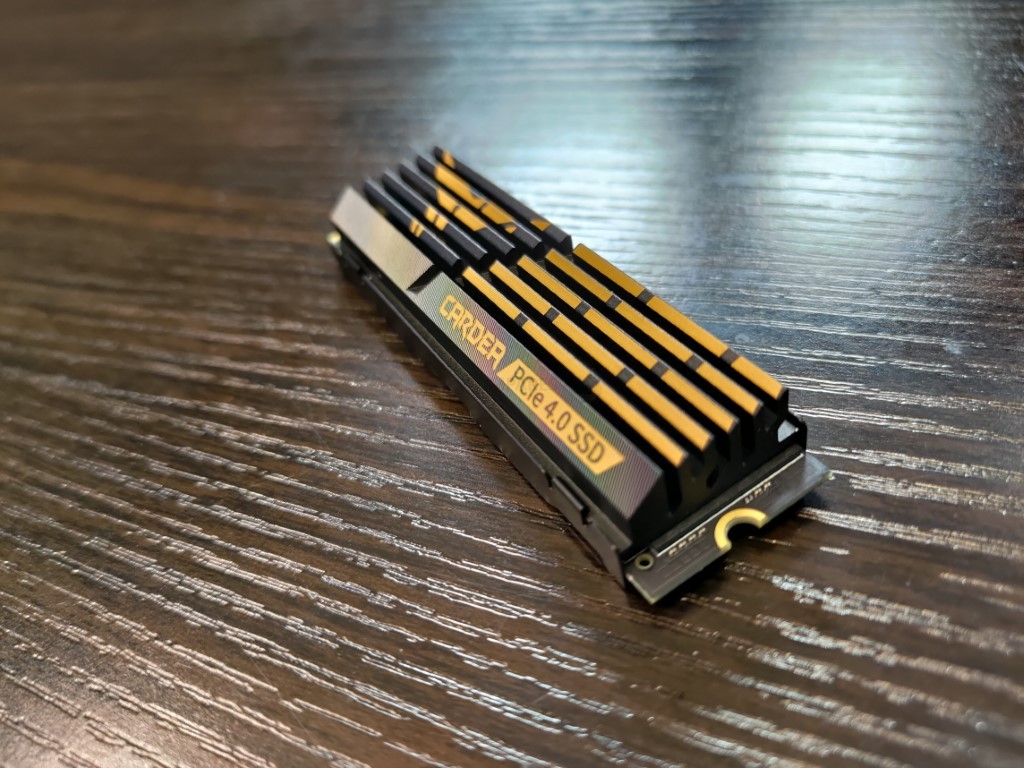
Overall, although I will get onto the hardware architecture of the T-Force Cardea A440 shortly, I have to give props to Teamgroup for selling this package at a lower price than alternatives from Samsung, WD and Seagate (which arrive 15-20% more expensive for heatsink included options), whilst still providing a high performance SSD.

So, what about PS5 deployment of the T-Force Cardea A440?
When installing the T-Force Cardea A440 into the PS5 M.2 Expansion storage bay, the difference in height between these two SSDs is immediately apparent! The thinner heatshield covers the SSD and leaves a significant area of space for active airflow (what there IS of it in the PS5 M.2 bay under that metal cover anyway).

Heatsink Version |
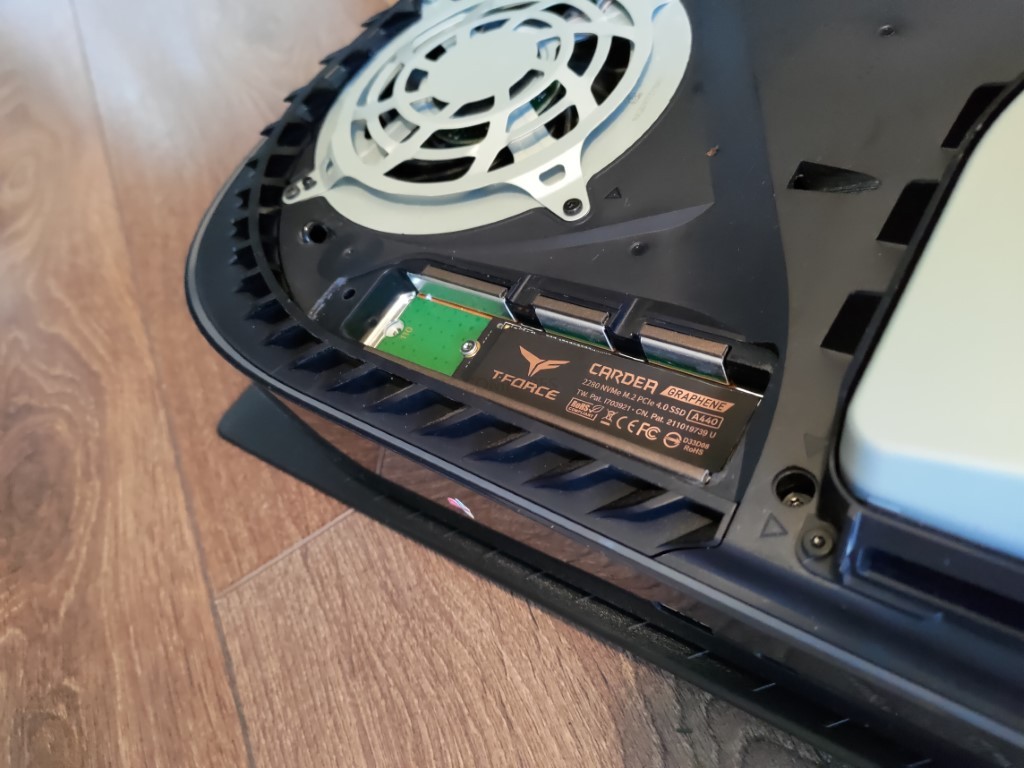
Heatshield Version |
Whereas the chunkier and taller heatsink installed with the T-Force Cardea A440 prevents the cover from being used and means that this heatsink will partially live in the airflow channel of the PS5’s vents and central cooling fan. Now, for the SSD – this is GREAT NEWS! A cooler SSD is (especially the controller) the considerably better it will operate. However, the PS5 cooling system is a quite delicately designed system that uses negative pressure (pulling air in one way and pushing out the other, forming a small vacuum) and if the heatsink got especially hot, that means that air entering the PS5 might well be a few degrees higher than normal. This is not the end o the world and not something we have been able to explore fully, but some users would prefer to have the cover on to ensure the PS5 does not get even 1 degree hotter than it needs to.

When I deployed the TeamGroup T-Force Cardea A440 SSD into the PS5, the console’s own internal benchmark (which is marked considerably different to popular PC benchmark tools such as AJA, BlackMagic, ATTO, CrystalDisk or PC Mark) gave us a very reassuring 6,557MB/s Read rating. Repeated testing of this SSD (i.e 3 more reformats for the benchmark ALL gave us between 6500-6550MVB/s – VERY impressive indeed, especially when you know that this is the 1TB drive and most 1TB SSDs we have tested on the PS5 have given us around 6000-6100MB/s at most.

After the benchmark is completed, the T-Force Cardea A440 SSD and it’s available storage immediately appeared in the PS5 storage manager for us. No delays, no formatting, just STRAIGHT into storage. Lovely stuff.

So, the PS5 benchmark of the T-Force Cardea A440 is good, but how does it compare with similarly built SSDs in the market?
TeamGroup T-Force Cardea A440 SSD Review – PS5 Benchmark
To put the T-Force A440 Cardea SSD PS5 Performance Benchmark into a little perspective, here is how it compares against the Addlink A95, Adata XPG Gammix S70, Sabrent Rocket 4 Plus and Gigabyte Aorus 7000s – four SSDs that are all PS5 supported and VERY similar architecture very little difference between the others in this tier, it is a solid benchmark. The T-Force Cardea A440 managed to hit the same highs as three other Phison E18 SSDs, all the while arriving $20-30 cheaper in most cases. Again, absolute music to my ears!
 |
 |
| Addlink A95 PS5 Benchmark – 6556MB/s | XPG GAMMIX S70 PS5 Benchmark – 6235MB/s |
 |
 |
| Sabrent Rocket 4 Plus – 6557MB/s | Gigabyte Aorus 7000s PS5 Benchmark – 6557MB/s |
Full PS5 Testing of the T-Force A440 Cardea is all available as a playlist over on the NASCompares YouTube channel. But for now, let’s carry on with looking at the hardware of the A440, how it conventionally benchmarks and how it compares with currently favourite PS5 SSDs like the WD Black and Seagate Firecuda 530,
| So that is the physical design of the T-Force Cardea A440 SSD. But what about the hardware components themselves? Does the T-Force Cardea A440 cut the mustard in terms of current generation hardware and protocols? Let’s find out. |
T-Force Cardea A440 SSD Review – Hardware Specifications
As you might expect from an M.2 NVMe SSD that boldly promises performance of over 7,000MB/s sequential read (ie BIG data), the hardware specifications and architecture of the T-Force Cardea A440 are quite modern. Indeed, for all the big talk of the Seagate Firecuda 530 hardware (still currently the ‘score to beat’ PCIE Gen4 m.2 NVMe right now) being top tier, the T-Force Cardea A440 is pretty darn similar on the spec sheet! Below is how it looks:
| Brand/Series | T-FORCE CARDEA A440 |
| PCIe Generation | PCIe Gen 4 |
| NVMe Rev | NVMe 1.4 |
| NAND | MICRON 3D TLC 96L NAND |
| Max Capacity | 2TB |
| Controller | Phison E18-PS5018 |
| Warranty | 5yr |
I know a lot of the above will seem needlessly technical, so below we can bring the most important considerations into sharper focus.
Hardware Focus of the T-Force Cardea A440 SSD Series
The first big, BIG thing to remember here is the controller, that Phison E18. An SSD is much like a microcosm version of a whole computer. The Controller is equivalent to the CPU, and Phison are one of the bigger 3rd party SSD controller manufacturers in the world! I say 3rd party, because some long-running storage brands like Samsung and WD have most of their development and hardware engineering ‘in-house’ and use their own branded controllers. Whereas some brands source some/all components for their SSDs from 3rd parties – which is not necessarily a bad thing for both them and the industry (there are pros and cons on either side). Phison has been at the cutting edge of this subject for years now and the E18 was first revealed last year in 2020, but due to the pandemic making storage trends unpredictable and semi-conductor shortages, most SSDs that utilized the Phison E18 eventually arrived in 2021. This controller is one of the biggest reasons that the T-Force Cardea A440 can actually back up it’s promises about the 7,000MB/s+ Sequential Read (sequential data = big chunks of data). However, that is not the only reason.

The NAND on the T-Force Cardea A440 is where the data lives! SSDs (as you no doubt know) do not use moving parts as found in traditional hard drives and instead uses cells that are charged and data is read/written to them in this process. The quality of the NAND and the layers used will make a big difference to the durability and performance of an SSD and although the T-Force Cardea A440 does not provide the best SSD in the industry at this tier right now (that, once again, goes to the Seagate Firecuda 530 at 176 layer 3D TLC NAND), it is bigger than most, arriving at 96 Layers of 3D TLC NAND. Although the majority of modern PCIe M.2 SSD use 3D TLC NAND (avoid QLC NAND like the PLAGUE btw!), most are still at 64 layers or so, so this is a big jump up for the T-Force Cardea A440 SSD.

Much like the Controller on the T-Force Cardea A440 being the ‘CPU’, it also has an area of memory. The T-Force Cardea A440 SSD uses 1GB DDR4 memory on board and this in conjunction with the SSD provides a massive body of data handling resources for getting your data moving through the SSD and out of the m.2 NVMe PCIe 4 interface. The amount of memory scales in conjunction with the 1TB or 2TB SSD you use, with 2GB of DDR4 at the on the 2TB tier, 1GB DDR4 on the 1TB, etc.

As mentioned, all available capacities of the T-Force Cardea A440 arrive at 2280 in length. This is quite normal for the 1TB and 2TB versions, but the fact that the 2TB can arrive on single-sided SSD boards is very impressive. Physical storage NAND is distributed evenly in order to space out the storage and allow even cooling, NAND wear and performance.

Finally, there is the M.2 NVMe connection. Not all m.2 SSDs are created equal and although M.2 SATA and M.2 NVMe look similar, they provide massively different performance and connectivity. However, the T-Force Cardea A440 takes it one step further, by using a newer generation of PCIe Connectivity. In short, M.2 NVMe SSDs are connected to the host PC/Console system via PCIe protocol (think of those slots that you almost always use for your graphics cards, but a much, MUCH smaller connector). These allow much larger bandwidth (ie maximum speed) for the connected storage media, Much like regular PCIe slots, they have different versions (i.E PCIe Gen 1, 2, 3, 4, etc) and also a multiplying factor (x1, x2, x4, etc). Up until around 18 months ago, the best M.2 NVMes were M.2 PCIe Gen 3×4 (so a maximum 4,000MB/s possible). However, never generation SSD like the T-Force Cardea A440 use PCIe Gen 4×4 (a potential 8,000MB/s possible) and it is only now that SSD controllers and NAND production has reached a point where it can catch up and fully saturate (i.e fill) this connection.

Overall, you really cannot fault the hardware inside/onboard the T-Force Cardea A440, as it is still (less than 6 months after release) higher performing in sequential Read and Write than many other M.2 NVMe PCIe 4 SSDs released in that time. Before we go into the full testing, however, it is worth taking a moment to look closely at the reported performance benchmarks of the T-Force Cardea A440, as although the performance seems stellar, there are areas such as IOPS and endurance when compared with its main rivals that are worth taking into consideration.

T-Force Cardea A440 SSD Review – Official Stats First
Before we conduct our own testing on this SSD, Let’s take a closer look at the reported specifications and benchmarks first. The T-Force Cardea A440 SSD arrives in multiple capacities (below). The Prices currently are a little inconsistent (with each higher capacity tier actually having a higher price per GB – quite unusual) likely due to the hardware shortages, the Pandemic, Chia has affected SSD availability in the last 18 months and most recently the announcement that PS5 supports this SSD and it has increased the current price of both models around 10% (which still keeps it less than the WD Blacck and Segate Firecuda in price at the time of writing). Below is a breakdown of how each T-Force Cardea A440 SSD compares:
| Brand/Series | T-FORCE CARDEA A440
|
Seagate Firecuda 530
500GB – $149.99, 1TB – $239.99, 2TB – $489.99, 4TB – $949.99 |
WD Black SN850
|
| PCIe Generation | PCIe Gen 4 | PCIe Gen 4 | PCIe Gen 4 |
| NVMe Rev | NVMe 1.4 | NVMe 1.4 | NVMe 1.4 |
| NAND | MICRON 3D TLC 96L NAND | 3D TLC Micron B47R 176L | BiCS4 96L TLC |
| Max Capacity | 2TB | 4TB – Double Sided | 2TB |
| Controller | Phison E18-PS5018 | Phison E18-PS5018 | WD_BLACK G2 |
| Warranty | 5yr | 5yr | 5yr |
| 500GB Model | N/A | ZP500GM3A013 | WDS500G1X0E-00AFY0 |
| Price in $ and $ | N/A | $139 / £119 | $119 / £99 |
| 1TB Model | TM8FPZ001T0C327 | ZP1000GM3A013 | WDS100T1X0E-00AFY0 |
| Price in $ and $ | $179 / £139 | $239 / £199 | $249 / £169 |
| 2TB Model | TM8FPZ002T0C327 | ZP2000GM3A013 | WDS200T1X0E-00AFY0 |
| Price in $ and $ | $349 / £289 | $419 / £379 | $399 / £339 |
| 4TB Model | N/A | ZP4000GM3A013 | N/A |
| Price in $ and $ | N/A | $949 / £789 | N/A |
| 500GB Model | N/A | ZP500GM3A013 | WDS500G1X0E-00AFY0 |
| Total Terabytes Written (TBW) | N/A | 640TB | 300TB |
| Mean Time Between Failures (MTBF, hours) | N/A | 1,800,000 | 1,750,000 |
| DWPD | N/A | 0.7DWPD | 0.3DWPD |
| 1TB Model | TM8FPZ001T0C327 | ZP1000GM3A013 | WDS100T1X0E-00AFY0 |
| Total Terabytes Written (TBW) | 700TB | 1275TB | 600TB |
| Mean Time Between Failures (MTBF, hours) | 1600000 | 1,800,000 | 1,750,000 |
| DWPD | 0.38DWPD | 0.7DWPD | 0.3DWPD |
| 2TB Model | TM8FPZ002T0C327 | ZP2000GM3A013 | WDS200T1X0E-00AFY0 |
| Total Terabytes Written (TBW) | 1400TB | 2550TB | 1200TB |
| Mean Time Between Failures (MTBF, hours) | 1600000 | 1,800,000 | 1,750,000 |
| DWPD | 0.38DWPD | 0.7DWPD | 0.3DWPD |
| 4TB Model | N/A | ZP4000GM3A013 | N/A |
| Total Terabytes Written (TBW) | N/A | 5100TB | N/A |
| Mean Time Between Failures (MTBF, hours) | N/A | 1,800,000 | N/A |
| DWPD | N/A | 0.7DWPD | N/A |
There are clear throughput improvements as you rise through the capacity tiers (not unusual), as does the rated 4K IOPS. Though one area worth focusing on a little is that TBW (terabytes Written) and DWPD (Drive writes per day), as this drive is rated a pinch higher than the Samsung 980 Pro and WD Black SN850 in terms of NAND lifespan on daily writes, likely down to that Micron 96 Layer 3D TLC NAND used, rather than the 96L/128L used by those used by competitors. This is an important point because the brand has significantly less pedigree in-home/business SSD media than the likes of Samsung, WD and Seagate and people will want to know they are going to get a product that lasts!
However, despite the use of the Phison E18 controller and 96 layer NAND, the reported IOPS on each capacity is actually a noticeable degree lower than those reported by their competitors. Indeed, the T-Force Cardea A440 is one of the few E18 SSDs that does not cross into the reported 1 Million IOPS mark, maxing out at 700-800K. This is still very impressive anyway, but it does make me wonder where the disparity stems from. Indeed, when you look at the bulk of PCIe 4×4 M.2 NVMe 1.4 SSD, that feature the E18 controller and 96L (or higher) on board, it really only leaves about 4 other SSDs in the market today that this can be compared against. The Sabrent Rocket 4 Plus, the MSI Spatium M480, the ADATA Gammix S70 and (current leader) the Seagate Firecuda 530. Of those, the only one that seemingly ‘out specs’ the T-Force Cardea A440 is the Seagate Firecuda 530. However, the T-Force Cardea A440 SSD has been available in the market for almost 3-4 months longer and has certainly embedded itself in the market at that time a fraction more. Below is how these two drives compare:
| Brand/Series | T-FORCE CARDEA A440
|
Seagate Firecuda 530
500GB – $149.99, 1TB – $239.99, 2TB – $489.99, 4TB – $949.99 |
WD Black SN850
|
| 500GB Model | N/A | ZP500GM3A013 | WDS500G1X0E-00AFY0 |
| Sequential Read (Max, MB/s), 128 KB | N/A | 7000MB | 7000MB |
| Sequential Write (Max, MB/s), 128 KB | N/A | 3000MB | 4100MB |
| 1TB Model | TM8FPZ001T0C327 | ZP1000GM3A013 | WDS100T1X0E-00AFY0 |
| Sequential Read (Max, MB/s), 128 KB | 7000MB | 7300MB | 7000MB |
| Sequential Write (Max, MB/s), 128 KB | 5500MB | 6000MB | 5300MB |
| 2TB Model | TM8FPZ002T0C327 | ZP2000GM3A013 | WDS200T1X0E-00AFY0 |
| Sequential Read (Max, MB/s), 128 KB | 7000MB | 7300MB | 7000MB |
| Sequential Write (Max, MB/s), 128 KB | 6900MB | 6900MB | 5100MB |
| 4TB Model | N/A | ZP4000GM3A013 | |
| Sequential Read (Max, MB/s), 128 KB | N/A | 7300MB | N/A |
| Sequential Write (Max, MB/s), 128 KB | N/A | 6900MB | N/A |
| Brand/Series | T-FORCE CARDEA A440 | Seagate Firecuda 530 | WD Black SN850 |
| 500GB Model | N/A | ZP500GM3A013 | WDS500G1X0E-00AFY0 |
| Random Read (Max, IOPS), 4 KB QD32 | N/A | 400,000 | 1,000,000 |
| Random Write (Max, IOPS), 4 KB QD32 | N/A | 700,000 | 680,000 |
| 1TB Model | TM8FPZ001T0C327 | ZP1000GM3A013 | WDS100T1X0E-00AFY0 |
| Random Read (Max, IOPS), 4 KB QD32 | 650000 | 800000 | 1,000,000 |
| Random Write (Max, IOPS), 4 KB QD32 | 700000 | 1000000 | 720,000 |
| 2TB Model | TM8FPZ002T0C327 | ZP2000GM3A013 | WDS200T1X0E-00AFY0 |
| Random Read (Max, IOPS), 4 KB QD32 | 650000 | 1,000,000 | 1,000,000 |
| Random Write (Max, IOPS), 4 KB QD32 | 700000 | 1,000,000 | 710,000 |
| 4TB Model | N/A | ZP4000GM3A013 | |
| Random Read (Max, IOPS), 4 KB QD32 | N/A | 1,000,000 | N/A |
| Random Write (Max, IOPS), 4 KB QD32 | N/A | 1,000,000 | N/A |
Yes, that is a LONG table, but you can immediately see that the Seagate Firecuda 530 raises the stakes on all of the key specifications. Although there are a number of micro reasons for this, the 176L NAND is the biggest factor here. Yes, that is why the Firecuda 530 commands a higher price tag. Additionally, the WD Black arrives at a better price point, higher IOPS in most tiers and the fact it does this whilst still hitting that 7,000MB/s certainly gives pause for thought. However, for many, the additional cost for higher durability they may never need, peak performance their core system will not reach and IOPS rating that their larger file handling will never utilize will mean that holding out for the Firecuda or WD Black SN850 is not in their interest. Both SSDs (on paper at this stage!) are fantastic examples of where consumer and prosumer SSDs are evolving towards. Though we cannot remove the fact that the T-Force Cardea A440 arrives at an excellent price point, even WITH two inclusive heat dissipation options included. The Seagate and WD versions of their drives with inclusive heatsinks will increase their prices 10-15%, thereby even further increasing the disparity in price here. Let’s get the T-Force Cardea A440 on the test machine!

Testing the T-Force Cardea A440 m.2 PCIE4 NVMe SSD
The T-Force Cardea A440 was selected for this test and it was tested using multiple benchmark tools, from a cold boot, in the 2nd storage slot (i.e not the OS drive). Each test was conducted three times (full details of this are shown in the YouTube Review of the T-Force Cardea A440 over on NASCompares):
Test Machine:
- Windows 10 Pro Desktop System
- Intel i5 11400 Rocket Lake – 6-Core 2.6/4.4Ghz
- 16GB DDR4 2666MHz Memory
- Intel B560M mATX Motherboard
- OS Storage, Seagate Firecuda 120 SSD
- Test SSD connected to Secondary PCIe Gen 4 M.2 Slot
Using CrystalDisk, we got a good measure of the drive and verified that this PCIe Gen 4 x4 SSD was indeed using the 4×4 lane. Additionally, the temp averaged out around 43C between each test being conducted, but at it’s peak, the T-Force Cardea A440 SSD and larger heatsink hit 53C.

The first tests were conducted using the ATTO disk benchmark software. The first was a 256MB test file size and below is a breakdown of the transfer rates and IOPS. The 2nd Test was a 1GB test file and finally, the last test was with a 4GB test file. The system was given 1-minute cool downtime between tests, no screen recording software was used (remove overhead) and a heatsink was used throughout (no reboots)
 |
 |
ATTO Disk Benchmark Test #1
256MB File PEAK Read Throughput = 5.59GB/s
256MB File PEAK Write Throughput = 5.47GB/s
 |
 |
ATTO Disk Benchmark Test #2
1GB File PEAK Read Throughput = 6.59GB/s
1GB File PEAK Write Throughput = 5.47GB/s
 |
 |
ATTO Disk Benchmark Test #3
4GB File PEAK Read Throughput =6.58GB/s
4GB File PEAK Write Throughput = 5.47GB/s
Next, although the ATTO tests were quite good, but I wanted something clearer, so I moved on to the Crystal Disk Mark testing to see how well it would handle our latest barrage of tests. The first test was the 1GB file testing, which measured both sequential and random, as well as the read and write IOPS. Tests were conducted on a 1GB, 4GB and 16GB Test File. I also included a mixed 70/30 read and write tasks to give a little bit more of a realistic balanced workload. These tests were conducted with 1-minute cooling break in between
CRYSTALDISK MARK 1GB TEST
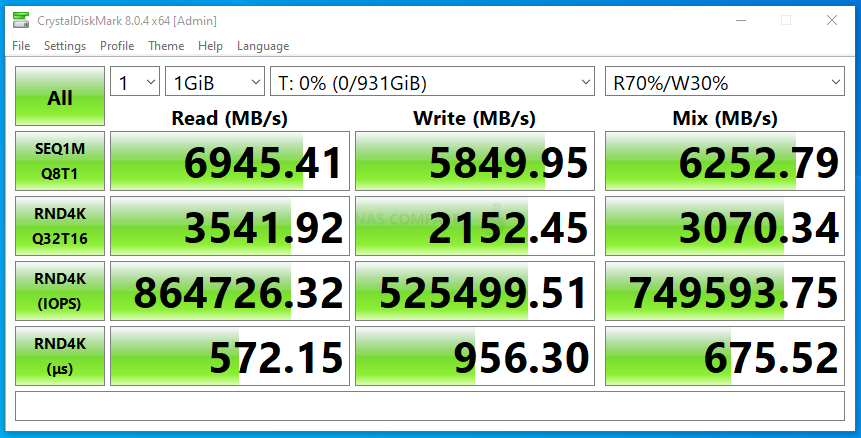
CRYSTALDISK MARK 4GB TEST

CRYSTALDISK MARK 16GB TEST

Next, I switched to AS SSD benchmark. A much more thorough test through, I used 1GB, 3GB and 5GB test files. Each test includes throughput benchmarks and IOPS that are respective to the larger file sizes (important, if you are reading this and trying to compare against the reported 4K IOPS from the manufacturer).
AS SSD Benchmark Test #1
 |
 |
AS SSD Benchmark Test #2
 |
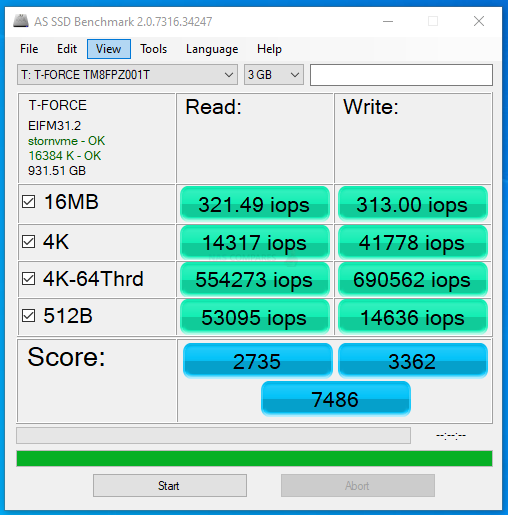 |
AS SSD Benchmark Test #3
 |
 |
Ordinarily, I would introduce tests like BlackMagic and AJA into the mix here, but even a short burst of testing on an NVMe like this would over saturate the cache memory on board. Nevertheless, in the short term we still could ascertain the reported performance on 1GB, 4GB and 16GB file testing was:
1GB AJA File Test Results (Peak) = 6001MB/s Read & 5715MB/s Write

4GB AJA File Test Results (Peak) = 5994MB/s Read & 5703MB/s Write

16GB AJA File Test Results (Peak) = 6015MB/s Read & 5654MB/s Write

Overall, the T-Force Cardea A440 was certainly able to provide some solid performance, as well as potentially exceed the test figures here on a more powerful machine. Given the reported Read and Write statistics that the brand has stated publically, I think there is enough evidence here to back up those claims. IOPs were actually higher than those provided by the brand, which was a very pleasant surprise, but again, we were testing very large file types, so this would have to be taken in context.
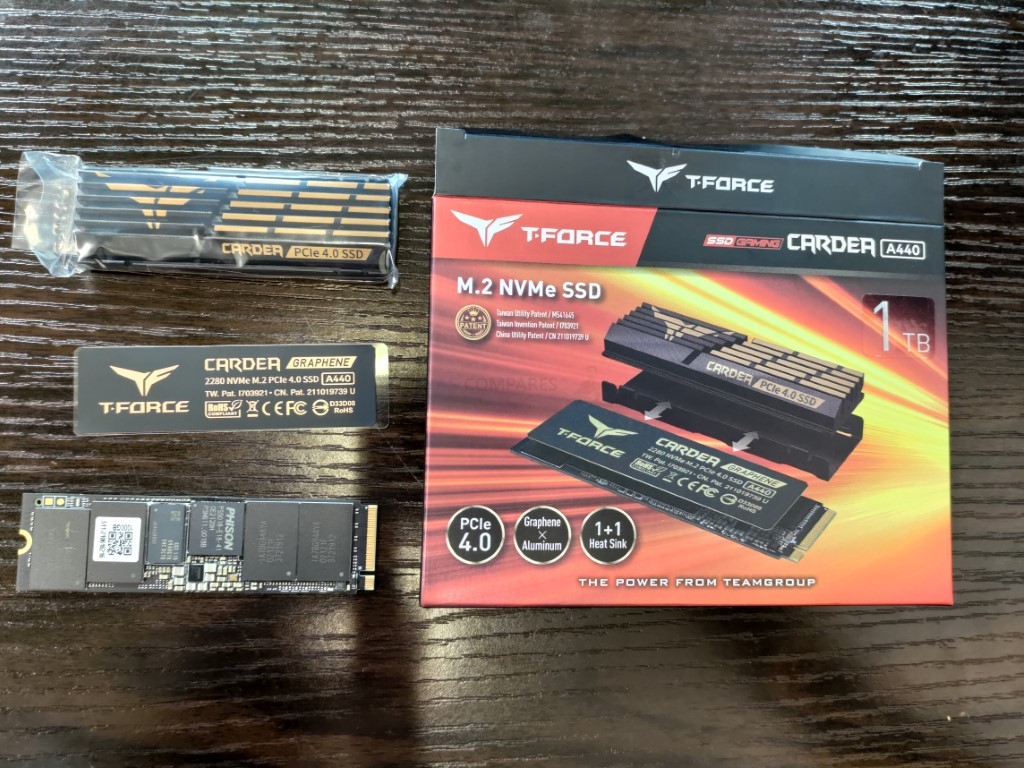
T-Force Cardea A440 SSD Review – Conclusion

The TeamGroup T-Force Cardea A440 started off in my eyes as ‘another Phison E18 SSD’, but very quickly became a genuinely stand out purchase indeed! Whatever way you look at it, the T-Force Cardea A440 drive is delivering exactly what it intends. In terms of performance, the 1TB SSD benchmarked 7000MB/s Seq Read and 6000MB/s sequential write straight out the gate and 860K IOPS without breaking a sweat. In terms of hardware, it arrives with exactly the top tier Controller+NAND+Mmeory combo that I would want to see in the PCIe4 storage tier. And in terms of Value, the SSD arrives at a competitive price point over many of its peers, whilst still proving two very useful heat dissipated options at no additional cost. Add PS5 dependant factors, such as the 6,500MB/s repeated console benchmark and a heatsink that happens to align very well with the PS5 designs cooling system and you can see how TeamGroup have gone from relative obscurity with console gamers to suddenly being a commonly mentioned name! PC users might be able to find a few better choices out there than the T-Force Cardea A440 in 2022 (with a T-Force Cardea PCIe 5 SSD reportedly making its way in H2 of the year and PCs having the better capability to harness 1 Million 4K IOPS SSDs above this one), but for the middle of the road PC gamers and PS5 gamers, the T-Force Cardea A440, there are very few better SSDs in the market right now you can choose over this one.
| PROs of the T-Force Cardea A440 | CONs of the T-Force Cardea A440 |
| Includes two different heat dissipation options (Heatshield and surrounding custom heatsink)
Impressive on-board cache recovery Good Price Point vs WD & Seagate Options Genuinely Impressive Performance for the price tag PS5 Compatibility Confirmed Cardea Series is pretty varied 4K Random IOPS exceeded the stats provided by the brand (a rare treat) The 1TB rated 6,550MB/s on the PS5 The Heatsink aligns with the PS5 Vent panels internally, which will be beneficial for airflow |
The retail package is a little underwhelming
Graphene Heatsink/Shield is single-use |
🔒 Join Inner Circle
Get an alert every time something gets added to this specific article!
This description contains links to Amazon. These links will take you to some of the products mentioned in today's content. As an Amazon Associate, I earn from qualifying purchases. Visit the NASCompares Deal Finder to find the best place to buy this device in your region, based on Service, Support and Reputation - Just Search for your NAS Drive in the Box Below
Need Advice on Data Storage from an Expert?
Finally, for free advice about your setup, just leave a message in the comments below here at NASCompares.com and we will get back to you. Need Help?
Where possible (and where appropriate) please provide as much information about your requirements, as then I can arrange the best answer and solution to your needs. Do not worry about your e-mail address being required, it will NOT be used in a mailing list and will NOT be used in any way other than to respond to your enquiry.
Need Help?
Where possible (and where appropriate) please provide as much information about your requirements, as then I can arrange the best answer and solution to your needs. Do not worry about your e-mail address being required, it will NOT be used in a mailing list and will NOT be used in any way other than to respond to your enquiry.

|
 |
Gl.iNet Flint 4 10G+2.5G Router Revealed @CES 2026
EVERYTHING NEW from Minisforum @ CES 2026
Gl.iNet Slate 7 PRO Travel Router (and Beryl 7) REVEALED
Minisforum N5 MAX NAS - 16C/32T, 128GB 8000MT RAM, 5xSATA, 5x M.2, 2x10GbE and MORE
The BEST NAS of 2026.... ALREADY??? (UnifyDrive UP6)
How Much RAM Do You Need in Your NAS?
Access content via Patreon or KO-FI





Discover more from NAS Compares
Subscribe to get the latest posts sent to your email.









A really good & detailed video ????
REPLY ON YOUTUBE
How should I install this drive when I have thermal pad on my Motherboard underneath and on top like the panel for the nvme ssd ? Which one is aluminium and which one should I install ?
REPLY ON YOUTUBE
Does it have DRAM?
REPLY ON YOUTUBE
Does the ssd decrease the games quality because it seems in your video that it does look a little washed out on the ssd side
REPLY ON YOUTUBE
the mtbf 3 million why did u but 1.6 million ???????????
REPLY ON YOUTUBE
should i get this over the WD-Black SN770?
REPLY ON YOUTUBE
Between this or the XPG 2TB GAMMIX S70 Blade which would be better for a Xmas gift??? Both 2tb
REPLY ON YOUTUBE
mine’s only reaching 3.5gb/s, what could be wrong?
REPLY ON YOUTUBE
I use both. The fin heatsink on top, the graphene at the bottom of the bracket. Is that fine?
REPLY ON YOUTUBE
installation would have been nice
REPLY ON YOUTUBE
How’s the drive’s longevity doing 8 odd months later?
REPLY ON YOUTUBE
Does anyone know if the 4tb version has chips on one side or both?
REPLY ON YOUTUBE
Did you measure the temperature of it? With and without ssd cover?
REPLY ON YOUTUBE
You’ve done such a great job with the whole PS5 M.2 upgrade situation. Great videos, really informative. Thank you ????
REPLY ON YOUTUBE
Ghost of Sunoma? It’s pronounced Susheema
REPLY ON YOUTUBE
Good content just got ps5 looking to get ssd going for 1tb thanks for vid to help me decide what to get got sabranet heatsink do just need ssd now just subscribed ????
REPLY ON YOUTUBE
Love these videos, great great insight on the product. Thank you!!
REPLY ON YOUTUBE
No! That ssd is last weeks news I’m here to learn about the graphene heatsink
REPLY ON YOUTUBE
When you do the testing on the PS5 , Can you please add a test where you use both the graphite sheet with the heatsink so we see if there’s a difference.???????????????? And good luck man , best reviews for SSDs on YouTube
REPLY ON YOUTUBE
Best review on this SSD for PS5 so far man , thank you so much bro
REPLY ON YOUTUBE
Are any M.2 22110 ssd cards for the PS 5 in the works for 2022?
The Elecgear Heatsink you featured in a previous video is no longer listed on Amazon. It was available for pre-order for late Jan or mid Feb 2022…but no longer.
REPLY ON YOUTUBE
Robbie, could you please get the PNY XLR8 CS3140? Preferably 1TB or higher? And do a performance test?
REPLY ON YOUTUBE